An Insight into the Anxiolytic and Antidepressant-Like Proprieties of Carum carvi L. and Their Association with Its Antioxidant Activity
Abstract
1. Introduction
2. Results and Discussion
2.1. Extract Biochemical Analysis
2.2. Evaluation of the Anxiolytic Activity of the Polyphenolic Fraction of C. carvi
2.2.1. Light and Dark Room
2.2.2. Open Field
2.3. Evaluation of the Antidepressant Activity of the Polyphenolic Fraction of C. carvi
2.3.1. Forced Swimming
2.3.2. The Tail Suspension Test
2.4. Antioxidant Activity
2.4.1. DPPH (2,2-Diphenyl-1-picrylhydrazyl) Antioxidant Activity
2.4.2. FRAP Method
3. Materials and Methods
3.1. Extraction
3.2. Animals
3.3. Antidepressant Activity
Predictive Test for Depression in Animals: Porsolt Test or Forced Swimming Test
3.4. Anxiolytic Activity
3.4.1. Tail Suspension Test
3.4.2. Open Field
3.4.3. Light and Dark Room
3.5. Antioxidant Activity
3.5.1. DPPH Test (1, 1-Diphenyl-2-picryhydrozyl)
3.5.2. Test of Iron-Reducing Power (FRAP)
3.6. Extract HPLC Analysis
3.7. Statistical Analysis of Results
4. Conclusions
Author Contributions
Funding
Institutional Review Board Statement
Informed Consent Statement
Data Availability Statement
Acknowledgments
Conflicts of Interest
References
- Yoon, J.-H.; Kang, M.-Y.; Jeung, D.; Chang, S.-J. Suppressing Emotion and Engaging with Complaining Customers at Work Related to Experience of Depression and Anxiety Symptoms: A Nationwide Cross-Sectional Study. Ind. Health 2017, 55, 265–274. [Google Scholar] [CrossRef] [PubMed]
- Es-Safi, I.; Mechchate, H.; Amaghnouje, A.; El Moussaoui, A.; Cerruti, P.; Avella, M.; Grafov, A.; Bousta, D. Marketing and Legal Status of Phytomedicines and Food Supplements in Morocco. J. Complement. Integr. Med. 2020. [Google Scholar] [CrossRef] [PubMed]
- Fajemiroye, J.O.; da Silva, D.M.; de Oliveira, D.R.; Costa, E.A. Treatment of Anxiety and Depression: Medicinal Plants in Retrospect. Fundam. Clin. Pharmacol. 2016, 30, 198–215. [Google Scholar] [CrossRef] [PubMed]
- Pan, S.-Y.; Zhou, S.-F.; Gao, S.-H.; Yu, Z.-L.; Zhang, S.-F.; Tang, M.-K.; Sun, J.-N.; Ma, D.-L.; Han, Y.-F.; Fong, W.-F.; et al. New Perspectives on How to Discover Drugs from Herbal Medicines: CAM’s Outstanding Contribution to Modern Therapeutics. Evid. Based Complement. Altern. Med. 2013, 2013, 1–25. [Google Scholar] [CrossRef]
- Fennane, M.; Rejdali, M. Aromatic and Medicinal Plants of Morocco: Richness, Diversity and Threats; Universite Mohammed V-Agdal Institut Scientifique: Rabat, Morocco, 2016. [Google Scholar]
- Fennane, M.; Tattou, M.I. Statistiques et Commentaires sur L’inventaire Actuel de la Flore Vasculaire du Maroc. Bull. Inst. Sci. 2012, 34, 1–9. [Google Scholar]
- Watson, M.F. The Genera of the Umbelliferae: A Nomenclator. M. G. Pimenov and M. V. Leonov. London: Royal Botanic Gardens, Kew and Botanical Garden of Moscow University, Russia. 1993. 156 Pp. ISBN 0 947643 58 3. £12.00 (Paperback). Edinb. J. Bot. 1995, 52, 92–93. [Google Scholar] [CrossRef]
- Johri, R. Cuminum Cyminum and Carum Carvi: An Update. Pharmacogn. Rev. 2011, 5, 63. [Google Scholar] [CrossRef]
- Miraj, S.; Kiani, S. Study of Pharmacological Effect of Thymus Vulgaris: A Review. Pharm. Lett. 2016, 8, 315–320. [Google Scholar]
- Amaghnouje, A.; Slighoua, M.; Es-safi, I.; El Jaoudi, R.; Elyoubi, A.; Bousta, D.; Grafov, A. Ethnobotanical Survey of Medicinal Plants Used in the Traditional Treatment of Depression and Anxiety in Fez-Meknes Region. Phytothérapie 2020, 18, 220–229. [Google Scholar] [CrossRef]
- Dhingra, D.; Chhillar, R.; Gupta, A. Antianxiety-like Activity of Gallic Acid in Unstressed and Stressed Mice: Possible Involvement of Nitriergic System. Neurochem. Res. 2012, 37, 487–494. [Google Scholar] [CrossRef] [PubMed]
- Bhutada, P.; Mundhada, Y.; Bansod, K.; Ubgade, A.; Quazi, M.; Umathe, S.; Mundhada, D. Reversal by Quercetin of Corticotrophin Releasing Factor Induced Anxiety-and Depression-like Effect in Mice. Prog. Neuropsychopharmacol. Biol. Psychiatry 2010, 34, 955–960. [Google Scholar] [CrossRef]
- Rai, A.; Gill, M.; Kinra, M.; Shetty, R.; Krishnadas, N.; Rao, C.M.; Sumalatha, S.; Kumar, N. Catechin Ameliorates Depressive Symptoms in Sprague Dawley Rats Subjected to Chronic Unpredictable Mild Stress by Decreasing Oxidative Stress. Biomed. Rep. 2019, 11, 79–84. [Google Scholar] [CrossRef] [PubMed]
- Ma, Z.; Wang, G.; Cui, L.; Wang, Q. Myricetin Attenuates Depressant-like Behavior in Mice Subjected to Repeated Restraint Stress. Int. J. Mol. Sci. 2015, 16, 28377–28385. [Google Scholar] [CrossRef]
- Mudgal, J.; Mallik, S.B.; Nampoothiri, M.; Kinra, M.; Hall, S.; Grant, G.D.; Anoopkumar-Dukie, S.; Davey, A.K.; Rao, C.M.; Arora, D. Effect of Coffee Constituents, Caffeine and Caffeic Acid on Anxiety and Lipopolysaccharide-Induced Sickness Behavior in Mice. J. Funct. Foods 2020, 64, 103638. [Google Scholar] [CrossRef]
- Lenzi, J.; Rodrigues, A.F.; de Rós, A.S.; de Castro, B.B.; de Lima, D.D.; Magro, D.D.D.; Zeni, A.L.B. Ferulic Acid Chronic Treatment Exerts Antidepressant-like Effect: Role of Antioxidant Defense System. Metab. Brain Dis. 2015, 30, 1453–1463. [Google Scholar] [CrossRef] [PubMed]
- Singh, T.; Kaur, T.; Goel, R.K. Ferulic Acid Supplementation for Management of Depression in Epilepsy. Neurochem. Res. 2017, 42, 2940–2948. [Google Scholar] [CrossRef] [PubMed]
- Sasaki, K.; Iwata, N.; Ferdousi, F.; Isoda, H. Antidepressant-Like Effect of Ferulic Acid via Promotion of Energy Metabolism Activity. Mol. Nutr. Food Res. 2019, 63, 1900327. [Google Scholar] [CrossRef]
- Kotwal, S.; Upaganlawar, A.B.; Mahajan, M.; Upasani, C. Protective Effects of Ferulic Acid in Alcohol Withdrawal Induced Anxiety and Depression in Mice. Malays. J. Med. Biol. Res. 2017, 4, 71–78. [Google Scholar] [CrossRef][Green Version]
- Lorigooini, Z.; Nouri, A.; Balali-Dehkordi, S.; Bijad, E.; Dehkordi, S.H.; Soltani, A.; Amini-Khoei, H. Ferulic Acid through Mitigation of NMDA Receptor Pathway Exerts Anxiolytic-like Effect in Mouse Model of Maternal Separation Stress. J. Basic Clin. Physiol. Pharmacol. 2020, 1. [Google Scholar] [CrossRef]
- Achenbach, T.M. Manual for the Child Behavior Checklist/4-18 and 1991 Profile; Department of Psychiatry, University of Vermont: Burlington, VT, USA, 1991. [Google Scholar]
- Mahendra, P.; Bisht, S. Anti-Anxiety Activity of Coriandrum Sativum Assessed Using Different Experimental Anxiety Models. Indian J. Pharmacol. 2011, 43, 574. [Google Scholar] [CrossRef] [PubMed]
- Jung, J.W.; Lee, S. Lee, S. Anxiolytic Effects of Quercetin: Involvement of GABAergic System. J. Life Sci. 2014, 24, 290–296. [Google Scholar] [CrossRef]
- Çam, M.; Hışıl, Y.; Durmaz, G. Classification of Eight Pomegranate Juices Based on Antioxidant Capacity Measured by Four Methods. Food Chem. 2009, 112, 721–726. [Google Scholar] [CrossRef]
- Ebrahimzadeh, M.A.; Nabavi, S.M.; Nabavi, S.F.; Bahramian, F.; Bekhradnia, A.R. Antioxidant and Free Radical Scavenging Activity of H. Officinalis, L. Var. Angustifolius, V. Odorata, B. Hyrcana and C. Speciosum. Pak. J. Pharm. Sci. 2010, 23, 29–34. [Google Scholar] [PubMed]
- Hinneburg, I.; Dorman, H.D.; Hiltunen, R. Antioxidant Activities of Extracts from Selected Culinary Herbs and Spices. Food Chem. 2006, 97, 122–129. [Google Scholar] [CrossRef]
- Desrumaux, C.; Risold, P.-Y.; Schroeder, H.; Deckert, V.; Masson, D.; Athias, A.; Laplanche, H.; Le Guern, N.; Blache, D.; Jiang, X.-C. Phospholipid Transfer Protein (PLTP) Deficiency Reduces Brain Vitamin E Content and Increases Anxiety in Mice. FASEB J. 2005, 19, 1–16. [Google Scholar] [CrossRef] [PubMed]
- Bilici, M.; Efe, H.; Köroğlu, M.A.; Uydu, H.A.; Bekaroğlu, M.; Değer, O. Antioxidative Enzyme Activities and Lipid Peroxidation in Major Depression: Alterations by Antidepressant Treatments. J. Affect. Disord. 2001, 64, 43–51. [Google Scholar] [CrossRef]
- Kuloglu, M.; Atmaca, M.; Tezcan, E.; Ustundag, B.; Bulut, S. Antioxidant Enzyme and Malondialdehyde Levels in Patients with Panic Disorder. Neuropsychobiology 2002, 46, 186–189. [Google Scholar] [CrossRef] [PubMed]
- Takeda, H.; Tsuji, M.; Miyamoto, J.; Matsumiya, T. Rosmarinic Acid and Caffeic Acid Reduce the Defensive Freezing Behavior of Mice Exposed to Conditioned Fear Stress. Psychopharmacology 2002, 164, 233–235. [Google Scholar] [CrossRef] [PubMed]
- Machado, D.G.; Bettio, L.E.B.; Cunha, M.P.; Santos, A.R.S.; Pizzolatti, M.G.; Brighente, I.M.C.; Rodrigues, A.L.S. Antidepressant-like Effect of Rutin Isolated from the Ethanolic Extract from Schinus molle L. in Mice: Evidence for the Involvement of the Serotonergic and Noradrenergic Systems. Eur. J. Pharmacol. 2008, 587, 163–168. [Google Scholar] [CrossRef]
- Priprem, A.; Watanatorn, J.; Sutthiparinyanont, S.; Phachonpai, W.; Muchimapura, S. Anxiety and Cognitive Effects of Quercetin Liposomes in Rats. Nanomed. Nanotechnol. Biol. Med. 2008, 4, 70–78. [Google Scholar] [CrossRef] [PubMed]
- Elizalde, N.; Gil-Bea, F.J.; Ramírez, M.J.; Aisa, B.; Lasheras, B.; Del Rio, J.; Tordera, R.M. Long-Lasting Behavioral Effects and Recognition Memory Deficit Induced by Chronic Mild Stress in Mice: Effect of Antidepressant Treatment. Psychopharmacology 2008, 199, 1–14. [Google Scholar] [CrossRef]
- Martin, E.I.; Ressler, K.J.; Binder, E.; Nemeroff, C.B. The Neurobiology of Anxiety Disorders: Brain Imaging, Genetics, and Psychoneuroendocrinology. Psychiatr. Clin. N. Am. 2009, 32, 549–575. [Google Scholar] [CrossRef]
- Borsini, F.; Meli, A. Is the Forced Swimming Test a Suitable Model for Revealing Antidepressant Activity? Psychopharmacology 1988, 94, 147–160. [Google Scholar] [CrossRef] [PubMed]
- López-Rubalcava, C. Strain Differences in the Behavioral Effects of Antidepressant Drugs in the Rat Forced Swimming Test. Neuropsychopharmacology 2000, 22, 191–199. [Google Scholar] [CrossRef]
- Detke, M.J.; Lucki, I. Detection of Serotonergic and Noradrenergic Antidepressants in the Rat Forced Swimming Test: The Effects of Water Depth. Behav. Brain Res. 1995, 73, 43–46. [Google Scholar] [CrossRef]
- Jamwal, N.S.; Kumar, S.; Rana, A.C. Antidepressant Activity of Methanolic Extract of Foeniculum Vulgare (Fennel) Fruits in Experimental Animal Models. J. Appl. Pharm. Sci. 2013, 3, 65–70. [Google Scholar]
- Shahamat, Z.; Abbasi-Maleki, S.; Motamed, S.M. Evaluation of Antidepressant-like Effects of Aqueous and Ethanolic Extracts of Pimpinella Anisum Fruit in Mice. Avicenna J. Phytomed. 2016, 6, 322–328. [Google Scholar]
- Karagözler, A.A.; Erdağ, B.; Emek, Y.Ç.; Uygun, D.A. Antioxidant Activity and Proline Content of Leaf Extracts from Dorystoechas Hastata. Food Chem. 2008, 111, 400–407. [Google Scholar] [CrossRef]
- Yıldırım, A.; Mavi, A.; Kara, A.A. Determination of Antioxidant and Antimicrobial Activities of Rumex Crispus L. Extracts. J. Agric. Food Chem. 2001, 49, 4083–4089. [Google Scholar] [CrossRef] [PubMed]
- Singleton, V.L.; Rossi, J.A. Colorimetry of Total Phenolics with Phosphomolybdic-Phosphotungstic Acid Reagents. Am. J. Enol. Vitic. 1965, 16, 144–158. [Google Scholar]
- Amaghnouje, A.; Mechchate, H.; Es-safi, I.; Alotaibi, A.A.; Noman, O.M.; Nasr, F.A.; Al-zharani, M.; Cerruti, P.; Calarco, A.; Fatemi, H.; et al. Anxiolytic, Antidepressant-Like Proprieties and Impact on the Memory of the Hydro-Ethanolic Extract of Origanum Majorana L. on Mice. Appl. Sci. 2020, 10, 8420. [Google Scholar] [CrossRef]
- Porsolt, R.D.; Le Pichon, M.; Jalfre, M. Depression: A New Animal Model Sensitive to Antidepressant Treatments. Nature 1977, 266, 730–732. [Google Scholar] [CrossRef] [PubMed]
- Yan, B.; Wang, D.; Xing, D.; Ding, Y.; Wang, R.; Lei, F.; Du, L. The Antidepressant Effect of Ethanol Extract of Radix Puerariae in Mice Exposed to Cerebral Ischemia Reperfusion. Pharmacol. Biochem. Behav. 2004, 78, 319–325. [Google Scholar] [CrossRef] [PubMed]
- Walsh, R.N.; Cummins, R.A. The Open-Field Test: A Critical Review. Psychol. Bull. 1976, 83, 482–504. [Google Scholar] [CrossRef] [PubMed]
- Malmberg-Aiello, P.; Ipponi, A.; Bartolini, A.; Schunack, W. Mouse Light/Dark Box Test Reveals Anxiogenic-like Effects by Activation of Histamine H1 Receptors. Pharmacol. Biochem. Behav. 2002, 71, 313–318. [Google Scholar] [CrossRef]
- Tepe, B.; Daferera, D.; Sokmen, A.; Sokmen, M.; Polissiou, M. Antimicrobial and Antioxidant Activities of the Essential Oil and Various Extracts of Salvia tomentosa Miller (Lamiaceae). Food Chem. 2005, 90, 333–340. [Google Scholar] [CrossRef]
- Shams Moattar, F.; Sariri, R.; Yaghmaee, P.; Giahi, M. Enzymatic and Non-Enzymatic Antioxidants of Calamintha Officinalis Moench Extracts. J. Appl. Biotechnol. Rep. 2016, 3, 489–494. [Google Scholar]
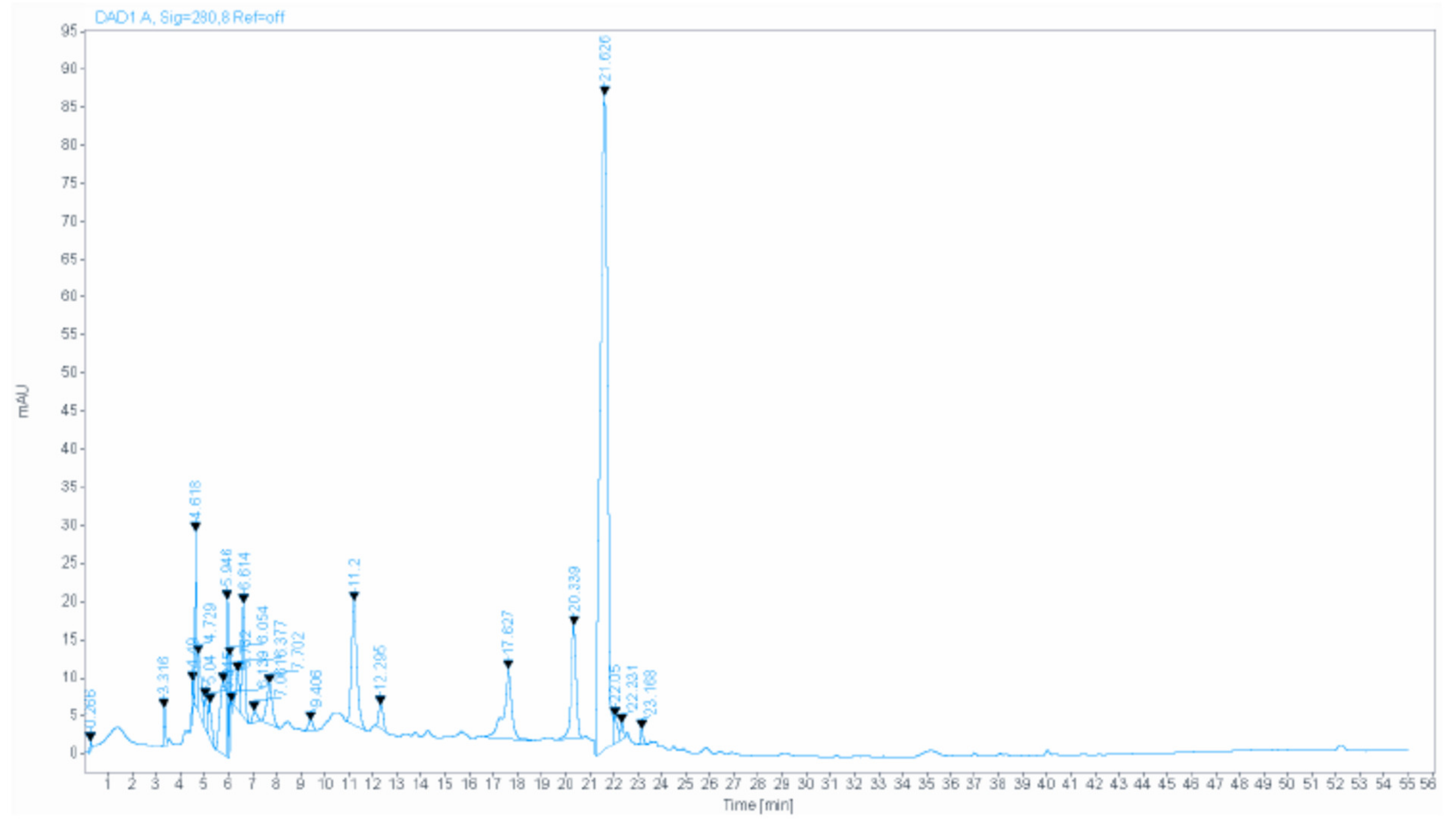
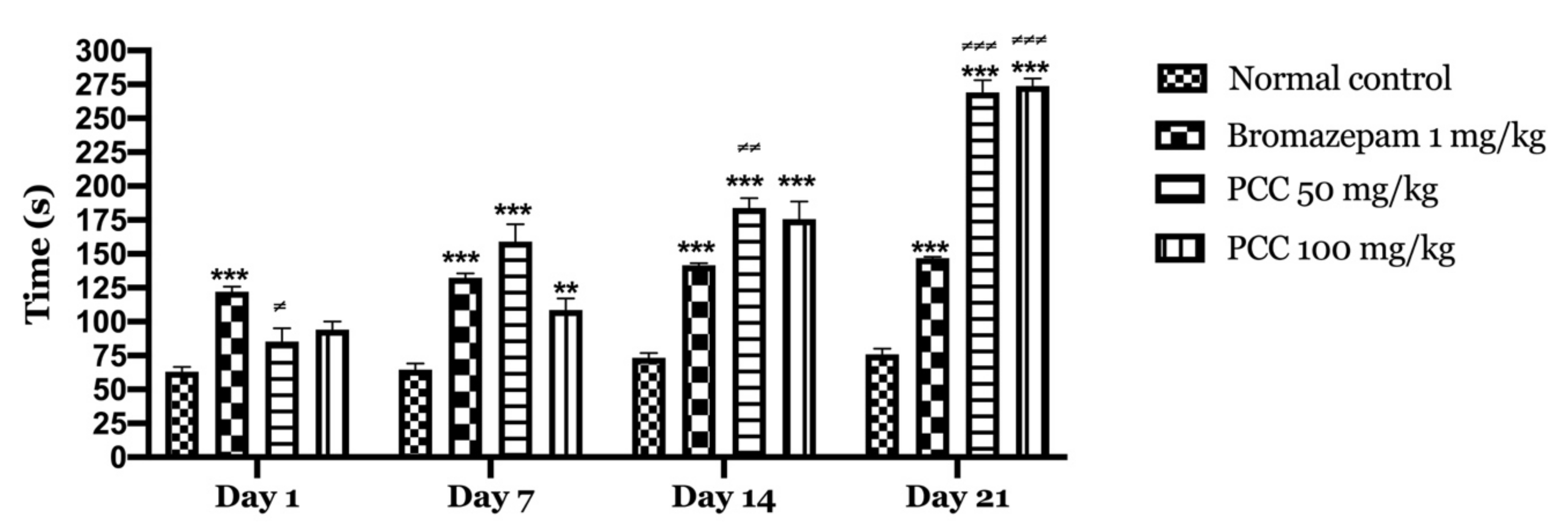

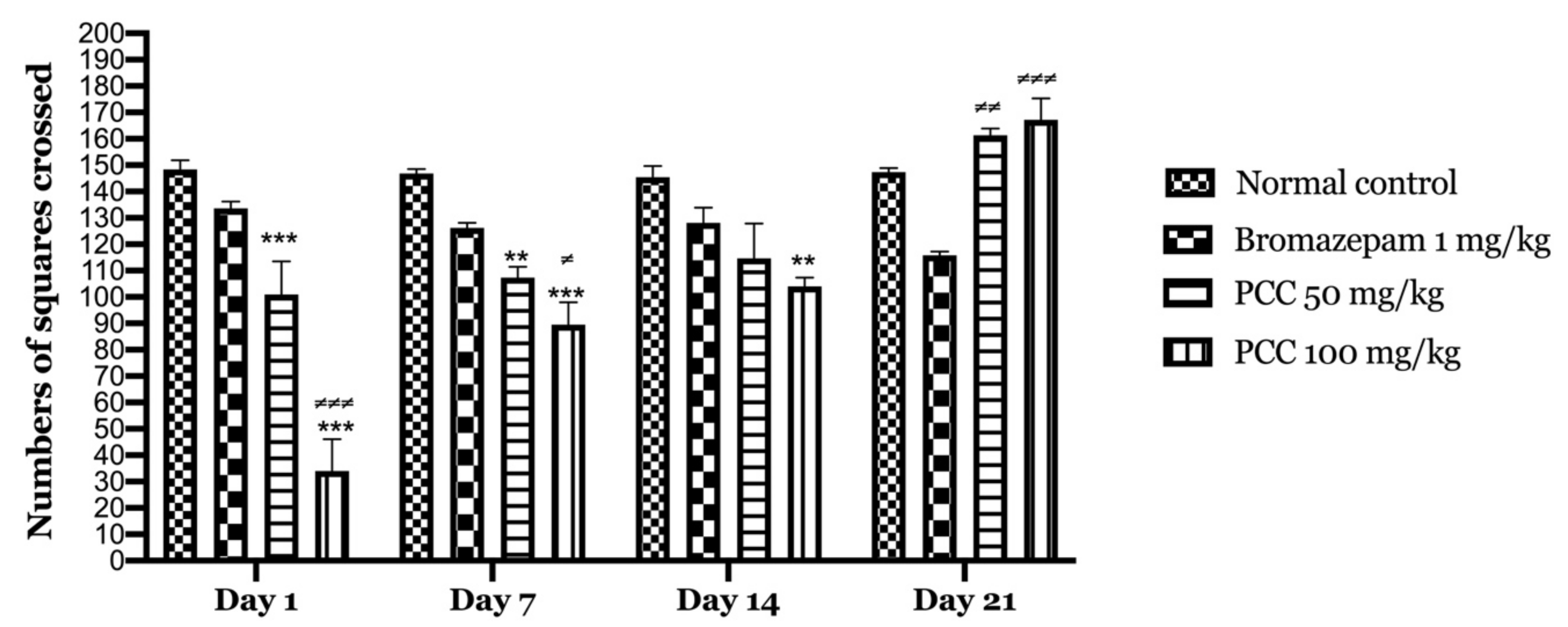

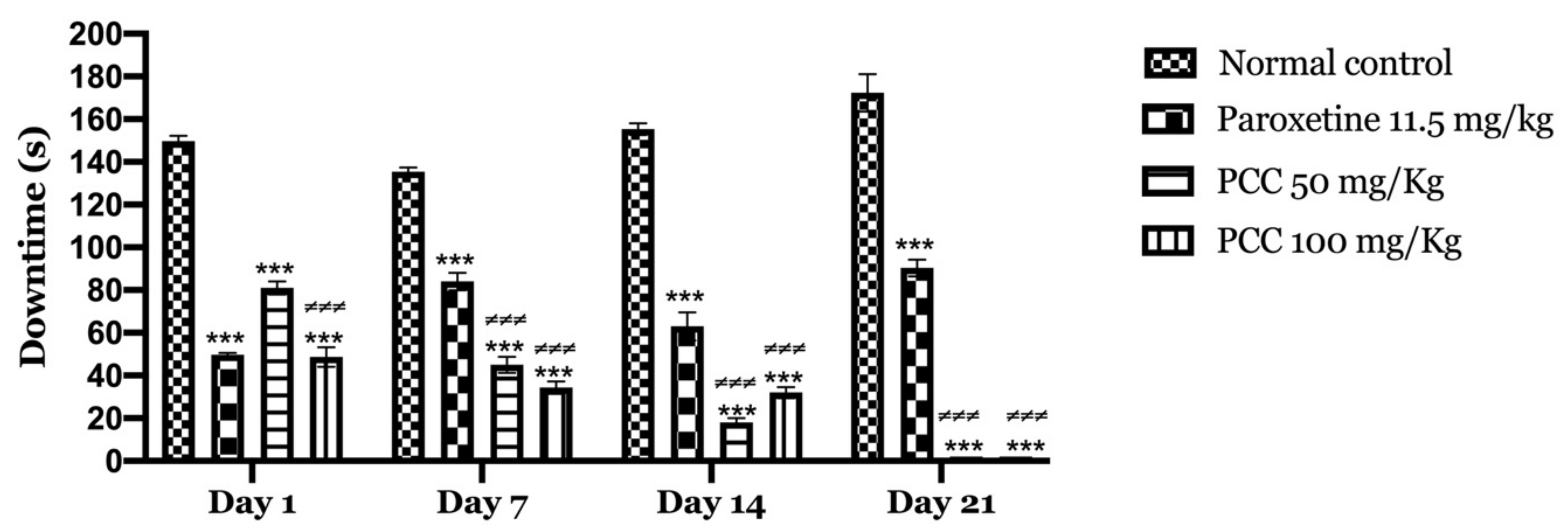

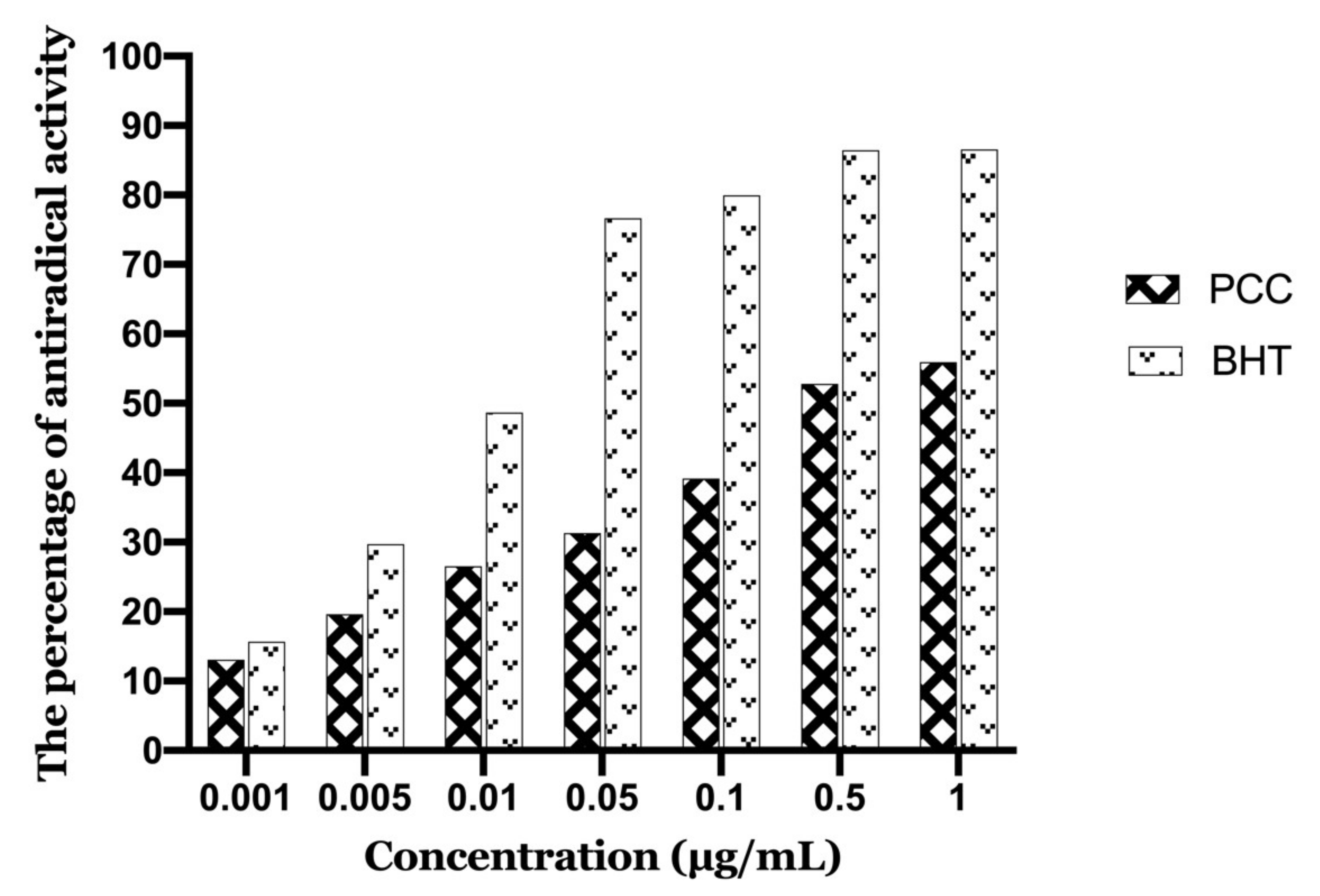
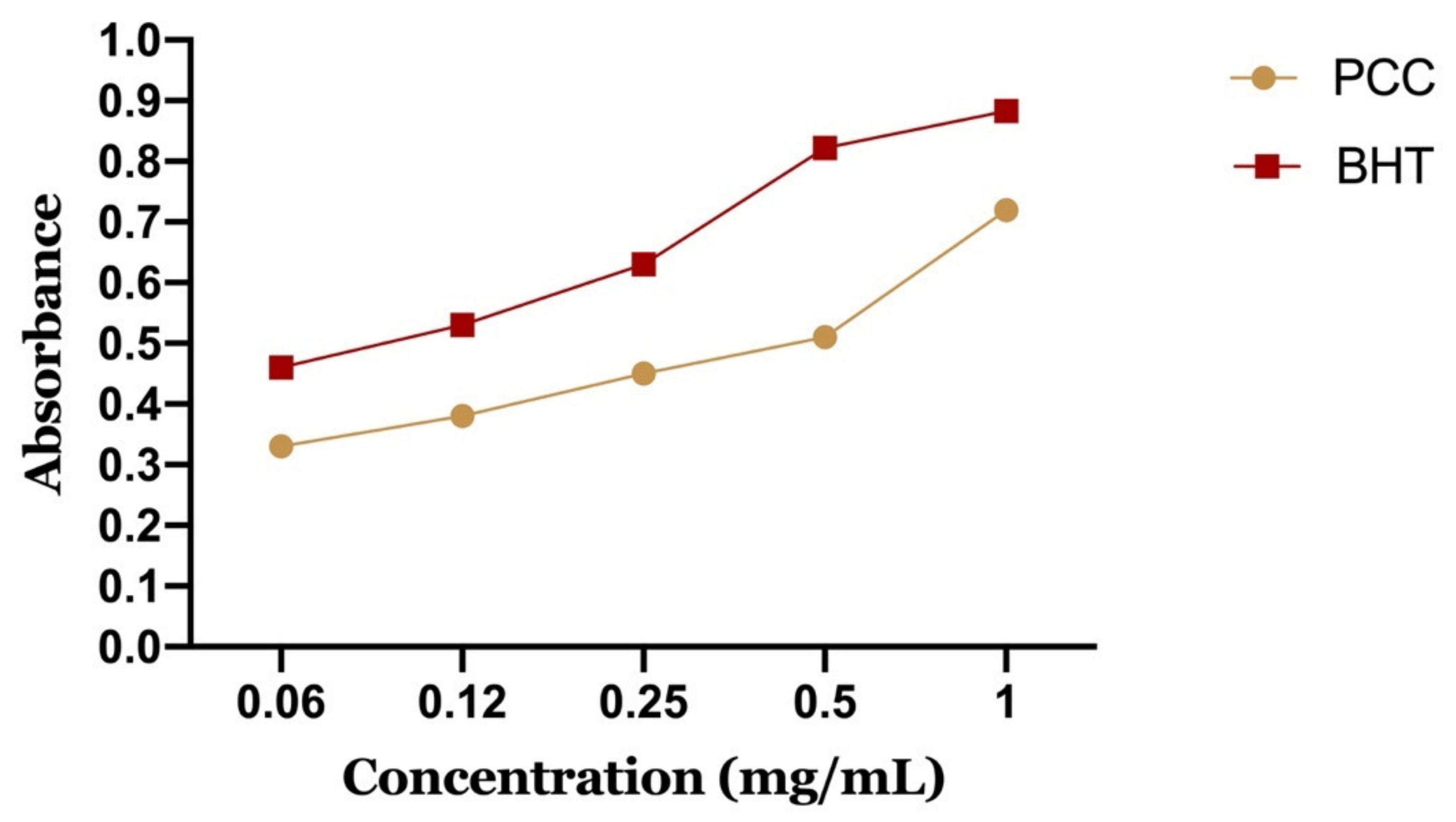
| Extract | Molecules | Retention Time | Retention Time (Standard) | Concentration (µg/mL) |
|---|---|---|---|---|
| PCC | Ferulic acid | 21.020 | 21.039 | 27.70 |
| Gallic acid | 6.614 | 6.645 | 9.17 | |
| Myricetin | 22.231 | 22.278 | 7.50 | |
| Catechin | 12.295 | 12.777 | 6.80 | |
| Caffeic acid | 17.627 | 17.336 | 6.77 | |
| Quercetin | 23.168 | 23.350 | 4.77 |
Publisher’s Note: MDPI stays neutral with regard to jurisdictional claims in published maps and institutional affiliations. |
© 2021 by the authors. Licensee MDPI, Basel, Switzerland. This article is an open access article distributed under the terms and conditions of the Creative Commons Attribution (CC BY) license (http://creativecommons.org/licenses/by/4.0/).
Share and Cite
Es-safi, I.; Mechchate, H.; Amaghnouje, A.; Jawhari, F.Z.; Al Kamaly, O.M.; Imtara, H.; Grafov, A.; Bari, A.; Bousta, D. An Insight into the Anxiolytic and Antidepressant-Like Proprieties of Carum carvi L. and Their Association with Its Antioxidant Activity. Life 2021, 11, 207. https://doi.org/10.3390/life11030207
Es-safi I, Mechchate H, Amaghnouje A, Jawhari FZ, Al Kamaly OM, Imtara H, Grafov A, Bari A, Bousta D. An Insight into the Anxiolytic and Antidepressant-Like Proprieties of Carum carvi L. and Their Association with Its Antioxidant Activity. Life. 2021; 11(3):207. https://doi.org/10.3390/life11030207
Chicago/Turabian StyleEs-safi, Imane, Hamza Mechchate, Amal Amaghnouje, Fatima Zahra Jawhari, Omkulthom Mohamed Al Kamaly, Hamada Imtara, Andriy Grafov, Amina Bari, and Dalila Bousta. 2021. "An Insight into the Anxiolytic and Antidepressant-Like Proprieties of Carum carvi L. and Their Association with Its Antioxidant Activity" Life 11, no. 3: 207. https://doi.org/10.3390/life11030207
APA StyleEs-safi, I., Mechchate, H., Amaghnouje, A., Jawhari, F. Z., Al Kamaly, O. M., Imtara, H., Grafov, A., Bari, A., & Bousta, D. (2021). An Insight into the Anxiolytic and Antidepressant-Like Proprieties of Carum carvi L. and Their Association with Its Antioxidant Activity. Life, 11(3), 207. https://doi.org/10.3390/life11030207








